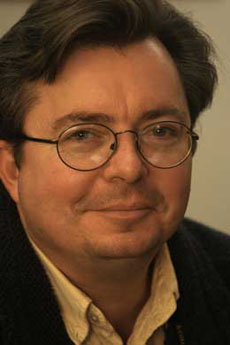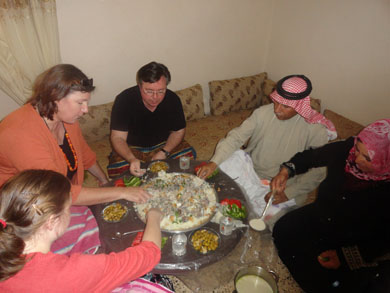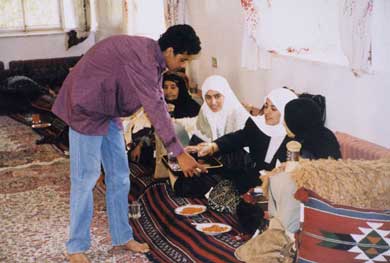
Andrew Shryock
“Like most social scientists, anthropologists tend to be lone wolves when it comes to research,” says Andrew Shryock, a dark, intense man with an easy sense of humor who looks something like the character actor Oliver Platt. In “Deep History: The Architecture of Past and Present,” published this fall by University of California Press, Shryock and co-editor Daniel Smail of Harvard University have persuaded a diverse group of anthropologists and historians to join a single pack. Their ambitious aim: to explore “the future of studying the past” and expand the understanding of what it means to be human by including more prehistoric evidence in mainstream approaches to history and cultural anthropology. “In this age of sub-disciplinary specialization and tension, Shryock embodies the ideal of anthropology as a conversation across fields,” says Tom Fricke, chair of the U-M anthropology department, part of the College of Literature, Science, and the Arts. “He takes real delight in bringing people from wildly different perspectives into conversations on a common theme.”
“Andrew’s ability to pull this project off comes about because of two traits that he possesses,” says U-M biological anthropologist John Mitani, who contributed to “Deep History.” “First, he’s not shy about thinking big and about the big-ticket items that have perplexed us all for centuries. Where do we come from? Who are we? Second, he has the academic chops to pull something like this off. In an era of academic specialization where we know more and more about less and less, Andrew knows a lot about everything.”

Shryock and his wife Sally Howell as guests in Jordan: the couple were southern ‘preachers’ kids’ and discovered that Arabs and southerners shared a lot in common. (Photo courtesy Andrew Shryock.)
In a recent New York Times article about the book, titled “History That’s Written in Beads as Well as in Words,” Patricia Cohen writes that Shryock and other proponents of deep history “seek to upend the discipline’s most precious precept and method: the reliance on the written record of the past.” Discoveries about the evolution of humans and related hominid species have been accumulating thick and fast in recent decades, Shryock points out. All kinds of materials besides written documents leave traces and should also count as evidence about humanity’s changing nature. These include fossils, tools, household items, pictures, structures, ecological changes, genetic variations, and, of course, beads, which humans began to produce and exchange in large numbers about 40,000 years ago. According to Shryock and Smail, beads have been used in many different ways in the course of time, from ornaments and markers of social status to a form of currency. In that last use, they share an unbroken genealogy with gold coins, fine jewelry, bank notes and the credit and debit cards we use today. “You can’t fully understand how money functions today without beads,” Shryock told Cohen.The book grew out of a workshop that Shryock and Smail organized in 2008. The next year, they met with a core group of contributors to sketch out the chapters—all jointly authored. The aim was to transcend specialization, grouping themselves by themes and tackling their subjects collectively: Body. Language. Food. Goods. Migration. Kinship. “People are jazzed by conversations across disciplinary lines, then it gets harder when you start writing,” says Shryock, who was awarded an Arthur F. Thurnau Professorship for excellence in undergraduate teaching in 2007 and was promoted to professor of anthropology this year. “But you work through the issues, and you begin to discover unexpected intellectual harmonies.””Deep History” is just one of two very different new books Shryock has published this year. The other is “Arab Detroit 9/11: Life in the Terror Decade,” published by Wayne State University Press, and co-edited by Shryock, Nabeel Abraham, a long-time collaborator who is a professor of anthropology at Henry Ford Community College, and Sally Howell, an assistant professor of history and Arab American Studies at U-M Dearborn. Howell also happens to be Shryock’s wife. “Sally likes to say that “Deep History” is about the first ten years of human history and “Arab Detroit 9/11″ is about the last ten years,” says Shryock. “Which means I still have plenty of work to do in the middle.” How Shryock became interested in Arabs, in Detroit and elsewhere, and in anthropology itself, for that matter, requires some understanding of his own deep history.
Shryock was born in the Missouri Ozarks and raised in Statesboro, a city in southeast Georgia immortalized in Blind Willie McTell’s song “Statesboro Blues.” “…Hand me those travel’n’ shoes, ’cause I’ve got the Statesboro blues…” His father was a minister in the local Christian Church. “That’s not a generic term, but a specific denomination,” Shryock explains. “Some might consider it fundamentalist or evangelical. But we were Bible-believing people. If Genesis said God created the world in six days and rested on the seventh, then that’s what we believed.”
Anthropology, Shryock observes, was not the cosmology of choice in his family. “But the world view I grew up with made sense of the human condition. And when I started studying anthropology at George Southern College in my hometown, I realized it had the same ambitions as religion: to understand the big questions, like how human society developed, why we speak different languages, why we have laws.”

Shryock says the customs and obligations around hospitality in the Arab world are deep and complex. (Photo courtesy Andrew Shryock.)
Shryock and his father had many heated discussions about his growing attraction to anthropology. “Disputes were part of our family culture,” says Shryock. Arguing about ideas was something they did more often than not at the dinner table. Crucially, they were not just a religious family but a “bookish” one, Shryock recalls. Although many evangelicals and fundamentalists seem to believe that faith requires them to reject science and reason, Shryock’s father was a learned man who did not see intellectual disputes as a form of heresy. Shryock decided to come to graduate school at Michigan in 1984 partly because he needed the financial support provided by a prestigious Regents Fellowship. He arrived in Ann Arbor on a Greyhound bus carrying a cardboard suitcase and wearing hand-me-down clothes. But need aside, the main reason he came here was his attraction to the department’s reputed strengths in ecological anthropology, an approach popular in the 1960s and 1970s that emphasized how human behavior was shaped by adaptations to the natural environment. He planned to investigate how life in a dry climate, like that of the Middle East, affected people’s behavior. But when he arrived here, his adviser, a social anthropologist trained at Oxford, sniffed, ‘We don’t really do that kind of work here anymore.’ Today, Shryock believes that his early interest in ecological anthropology, with its strong deterministic view of the human condition, functioned for him like a kind of intellectual methadone. “Coming off a strong, confident, religious view of human nature, ecological anthropology offered a substitute that made sense to me,” he says. But even after he’d kicked that mindset, Shryock found that he was still interested in the Middle East, a region he had first come to know and love, when he was a boy, as the Holy Land.His interest in the region only intensified when he took a summer course at an Arabic language school in Vermont. It was there that he met his future wife, Sally Howell. And they fell in love in Arabic. “We were both PKs—preacher’s kids,” says Shryock. Both were from the South. But Sally’s knowledge of the Middle East was more direct than Andrew’s. As an undergrad, she had travelled with a Presbyterian youth group to Nazareth, then spent her junior year in Cairo. Like Andrew, she felt a strong affinity for the people of the Middle East, for somewhat different reasons: the Arabs she met seemed a lot like Southerners to her. “I was born and raised in a garrulous, social, hospitable southern family,” she said. “My family always made a big deal over guests, and so did Arabs. My parents were old-fashioned when it came to gender, and so were Arabs. Also the Arabs I met were very animated, like my family and a lot of Southerners we knew, not at all reserved. It’s a comparison no one likes—Southerners don’t want to be compared to Arabs, and Arabs don’t want to be compared to Southerners.” But there it is.After Shryock was awarded a Fulbright fellowship for study abroad, he and Howell wound up in Jordan. He conducted classic ethnographic research on the transition from oral to written histories among the Balga Bedouin tribes, who had lived in what is now Jordan long before the Hashemites became the country’s rulers in the 1920s. The Bedouin wanted Shryock to write their stories down, but the process was more like a delicate diplomatic transaction than a simple, straightforward transcription. “In the oral tradition, you adapt the story to your audience,” Shryock explains. “But when you write a history for publication, all kinds of people will read it, and disputes occur. ‘That’s not how it happened,’ people would say. ‘Why don’t you talk to this person, he’ll tell you what really happened.'”The content of Bedouin stories provided Shryock with the material for his doctoral dissertation and his first book, “Nationalism and the Genealogical Imagination: Oral History and Textual Authority in Tribal Jordan.” But the context in which Bedouin told their stories is what really impressed Shryock and provided him with the subject that has remained an enduring fascination—hospitality. “The only way to get the oral histories—the way I wanted to hear them—was to share a meal, very often two or three times,” Shryock says. “So even though the stories themselves were often about wars and feuds, I learned about them in an atmosphere of hospitality.”He’s come to realize that his interest in the subject of hospitality actually predates his time in Jordan, however. In 1984 he received an award from the Georgia Academy of Sciences for that year’s outstanding student paper, on the subject of the Native American custom of potlatch, a gift-giving festival in which high status hosts entertain and house guests from other villages. And his interest in the potlatch probably came from all the visiting and hosting he did as a preacher’s kid.”We lived right next to the church, and every Sunday after the service, people would come to our house or we would visit theirs,” Shryock recalls. “People went to incredible lengths to prepare for our visits and impress us. They would even put a Bible out on the coffee table because that’s something they thought we would appreciate. And my mother used to exert enormous energy in inviting people over, making sure other people didn’t feel excluded, cooking, and preparing for visitors. Our whole family bought into the grand theater this involved. It was very similar to the way the Bedouin do hospitality, but Bedouin families are much, much better at it.”
Shryock is currently working on what he calls his “forever” book, on the politics of hospitality. And he’s also engaged in a number of collaborations, one with U-M biological anthropologist John Mitani, exploring why humans are the only primates who routinely visit across local breeding groups. “As a species,” Shryock says, “we are very good at sharing, even with non-kin and individuals we don’t know.” A third line of work, often in collaboration with Howell, involves Islamophobia and Muslim-American identity, carrying on his long interest in Arab and Muslim Americans. One of their joint projects—Building Islam in Detroit—, documents the area’s mosques as a way of understanding how the city’s Muslim population has evolved over time.
Howell and Shryock have worked in the Detroit area Arab American community since long before the attacks of September 11. Their latest book shows that much in the collective life of Arab Detroit seems to be working well, even under heavy political pressure. “By 2001, the community was so strong and successful, with so many ties to mainstream political and business leaders, that people knew how to manage the post-9/11 backlash. Arabs were not seen locally as strangers,” says Howell. “So this community has been able to weather the storm pretty well, and has suffered fewer repercussions so far than Arab Americans in many other places.”But as they note in the last chapter of “Arab Detroit 9/11: Life in the Terror Decade,” even though an awareness of Arab Detroit’s past and an appreciation of the vitality of its present can be a source of strength to the city’s Arabs and Chaldeans, concerns about discrimination and violation of civil liberties continue. The recent controversy over the Pittsfield Township decision to deny a building permit for a Muslim school is a recent example, as are attempts to pass “anti-Sharia” laws in Michigan and other states. As new political crises erupt in the Middle East, Howell and Shryock fear, hostility toward Detroit’s Arab community will return, “like an unwelcome guest at their front door.”


